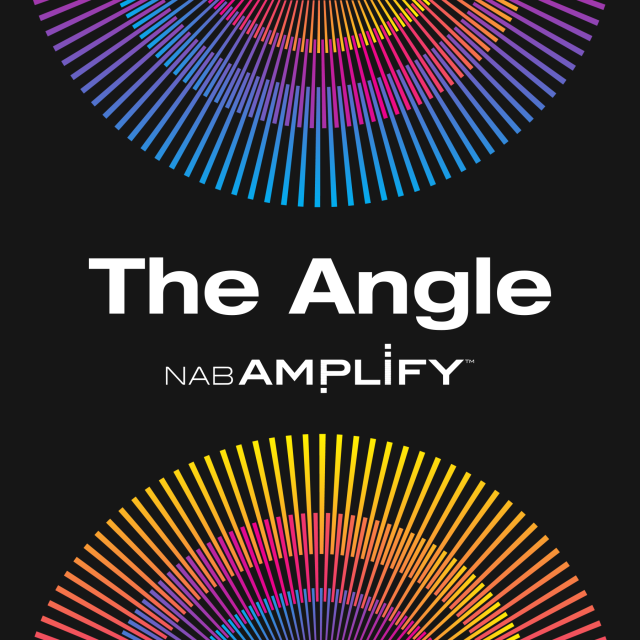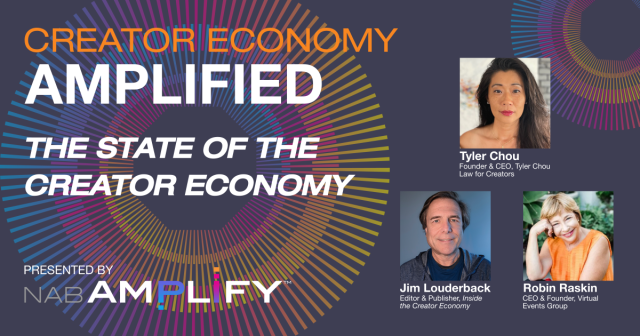Watch “Creator Economy Amplified: Building the Creative Stack.”
TL;DR
- Blackmagic Design’s Bob Caniglia joins Jim Louderback, editor & publisher of “Inside the Creator Economy,” and veteran journalist Robin Raskin to discuss the essential hardware that powers today’s creator economy, offering a roadmap for assembling a creative stack that aligns with both vision and budget.
- The pandemic has made production equipment more accessible, enabling home-based, professional-grade content creation and lowering entry barriers in the creator economy.
- Advances in LED lighting and microphones have transformed production, significantly improving content quality through better lighting and audio.
- AI integration and virtual studios are reshaping content creation, with metadata and shoppable videos poised to enhance engagement and monetization.
- Choosing scalable and modular equipment for new studios is essential, supporting future growth and avoiding the need for frequent, expensive upgrades.
Navigating the creator economy is akin to exploring a vast digital ecosystem, where content is the currency and creativity knows no bounds. Advancements in technology have leveled the playing field, equipping creators with the tools to turn visions into visuals and ideas into impact like never before.
This shift towards democratization has opened doors for creators at all levels, breaking down traditional barriers and offering new opportunities to engage and captivate audiences. However, the path to creating content that truly resonates with audiences is not without its challenges. Beyond creativity and storytelling, it’s crucial to use the right tools. They not only enhance a creator’s vision but also ensure that the final product stands out in a crowded digital space, and in today’s fast-paced creator economy, leveraging these tools effectively can significantly influence a creator’s ability to connect with their audience.
As part of NAB Amplify’s “Creator Economy Amplified” series, Bob Caniglia, director of sales operations at Blackmagic Design, sat down with Jim Louderback, editor and publisher of Inside the Creator Economy, and veteran journalist Robin Raskin, founder and CEO of Virtual Events Group, to share insights on the essential hardware that powers today’s creator economy. These industry pros offer a roadmap for assembling a creative stack that aligns with both vision and budget — watch the full conversation in the video at the top of the page.
The Affordable Production Revolution
The pandemic has sparked significant changes in content creation, shifting how and where creators bring their ideas to life.
“What has happened over the last couple of years since the pandemic is a lot of people have been able to purchase equipment that allows them to do productions at home that they may not have considered in the past,” Caniglia, who has worked in the film and television industry since 1985, recounts, reflecting on this evolution and highlighting a broader trend.

“At Blackmagic,” he continues, “we’ve been able to create some of those products in a price range that makes it very affordable. So people are starting to buy little switchers and some cameras, and the next thing you know, they’ve set up an entire studio.”
This trend towards democratization has significantly impacted the creator community. It has leveled the playing field, allowing emerging creators to produce content that can stand alongside that of more established names.
The result is a more vibrant and diverse ecosystem, enriched by a wider array of voices and perspectives. By making professional-grade production more accessible, the industry isn’t just changing the tools creators use; it’s transforming who gets to tell stories and how those stories reach audiences around the globe.
Lighting and Audio: The Pillars of Quality Content
When it comes to producing quality content, lighting and audio are non-negotiable, Louderback and Raskin agreed. The duo is behind the all-new Creator Lab at NAB Show, a hub for exploring the latest trends and technologies with a full schedule of talks and hands-on workshops featuring industry pros.
“Lighting is just so important,” Louderback emphasizes. “There are all sorts of inexpensive LED lights out now that can do amazing things,” he says, noting that the advent of affordable LED lighting solutions has revolutionized the way creators approach production, allowing for professional-quality lighting setups on a budget.
“You can have lights that plug into your smart home so that you can say ‘I want to turn on the studio lights,’” he adds as an example, “So look into lights again, because they get cheaper and cheaper and better and better. And there’s so much more you can do with them.”
Audio, says Raskin, is another element that is often overlooked. The pandemic underscored the necessity of high-quality audio as creators sought to improve their production values. Upgrading from built-in laptop speakers and webcams to superior microphones can dramatically enhance the clarity and fidelity of audio, she advises, elevating the overall quality of the content.
“People don’t realize how important it is,” she says, sharing that while she employs a range of solutions she’s currently using a podcasting mic from Shure. “The sound is crisp and accurate, and so much better than my laptop.”
Connectivity and Mobility: The New Frontiers
In today’s creator economy, the ability to produce content remotely and on the go has become invaluable. “Think about your home networks,” Louderback urges, stressing the importance of robust Wi-Fi connectivity for seamless content creation and live streaming.
“If you’ve got an old wireless setup, and you can’t run a wire from your router to your desktop or your notebook, upgrade your internet, think about some of the newer versions of Wi-Fi, think about running multiple different base stations, think about any way that you can go out and do a better job with Wi-Fi.”
To boost connectivity, Louderback recommends Wi-Fi 6-supported products in particular, along with employing multiple base stations to your home router. “All of these things can make sure that you don’t get dropouts, and that everything that’s going into your computer gets up into the cloud without losing lots of fidelity.”
Wireless microphone technology has also improved drastically, he says. “Anker and DJI and Rode, and a couple of others, all have these really cool wireless mic kits, where you get a really small little pod that you can stick on yourself or the person you’re interviewing.”
Using wireless audio in the field “sounds really good,” and makes production “so much easier,” Louderback says. “That little microphone you stick on the lapel, it actually will record the audio and save a version of it on that as well. So if something goes wrong in the field, it always does, you’re going to have an ISO of that audio so that you can fix it and post.”
Caniglia touted the Blackmagic Camera app for iPhone as a game-changer for mobile content creation, offering professional camera settings and cloud integration for easy file transfer and editing.
“[The Blackmagic Camera app] creates a better version of your iPhone. In terms of recording for video, it has a lot more of the settings that you would see in a Blackmagic camera,” he says, explaining that the app is also tied to Blackmagic Cloud, which allows users to send files directly to the cloud so they can be edited from the field. The app also allows creators to use their phones as a second camera and still achieve high quality results. “We’re going to see a lot of people on the uptake of doing that.”

Why subscribe to The Angle?
Exclusive Insights: Get editorial roundups of the cutting-edge content that matters most.
Behind-the-Scenes Access: Peek behind the curtain with in-depth Q&As featuring industry experts and thought leaders.
Unparalleled Access: NAB Amplify is your digital hub for technology, trends, and insights unavailable anywhere else.
Join a community of professionals who are as passionate about the future of film, television, and digital storytelling as you are. Subscribe to The Angle today!
Beyond hardware, software also plays a crucial role in the creative stack. Caniglia discussed how DaVinci Resolve, the company’s free editing and color grading software that has become a cornerstone for post-production, is enabling creators to collaborate and expedite the finishing process without compromising on quality.
“Almost 40 years ago, [when] I went to editing school, I would have needed $500,000 to set up an edit system in my house. And now it’s free.”
Looking Ahead: The Future of Video Production
As the creator economy evolves, so too do the tools and technologies at creators’ disposal. Louderback expresses excitement about the integration of AI in video production, particularly in audio enhancement, foreseeing a future where AI acts as a “copilot” for creators.
“I want AI in my camera and AI on my phone, AI in my audio, so I’m all up and ready to do a shoot,” he enthuses. “I can’t wait to see that happen.”
Studios, says Raskin, will become a thing a past, “at least the ones with nails and hammers and wood.” Instead, virtual studios will become the norm. “So your studio can be as big or small or anywhere in the world, and that’s going to change all sorts of events and all sorts of content.”
Metadata will turbocharge video’s utility, Raskin predicts. “Video, I used to call it unconstructed data, it’s just there, nobody knew what to do with it,” she explains. “Well, now, through meta tagging… all of a sudden video becomes something that’s structured, and you can learn what keeps people’s engagement, what gets them involved.”
Shoppable videos will are another big trend to watch out for, she says. “You can see Amazon and some of the big players, Etsy, Pinterest, all doing shoppable videos, and it’s going to be even more so this year, we’re all going to be selling things to each other.”
“When you think about buying your initial setup, when you’re just getting started, make sure that it’s stuff that you can grow with,” Louderback advises, noting that many camera setups, and other equipment, allow users to build systems on top of them. “You can stack, you can grow with your equipment. Make sure you look for modularity and upgrade ability as well,” he says, “rather than buying something, and then be like, ‘I’m gonna throw it out, and I’m gonna upgrade to something new.’”


